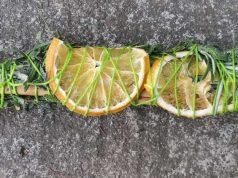From Marjory Wildcraft’s GrowYourOwnGroceries.org.
Yes, the prepackaged probiotic capsules and tablets in health food stores can be pricey. But there’s no need to break the bank for expensive products when you can indulge in your own DIY recipes to make your own probiotics at home, and cheaply, too.
Just be aware that when it comes to ferments, the names people use can get a little murky.
#1 – Sauerkraut
Got cabbage? You’re probably familiar with this one already, but it’s such an excellent source of probiotics that it deserves our top spot. Even if you’re not growing your own, cabbage is dirt cheap to buy. The Environmental Working Group even listed non-organic cabbage as being low in pesticides (#4 on the “Clean 15” list), so there’s really no excuse. And yes, you can easily make sauerkraut in as little as 5 days, without using salt, and using repurposed mason jars.
Of course, you can get all fancy and use a pickling crock, add in mint, dill, ginger, and other herbs and spices, add in a package or two of pricey starter culture, and let the ‘kraut ferment for up to 2 months. If you’re interested in a more complex ‘kraut, see this article: Make the Perfect Home Fermented Sauerkraut – It’s All in the Temperature.
Here’s that simple, cheap, DIY recipe you can do right away (feel free to double or triple the recipe):
Salt-less Sauerkraut Recipe
• 1-2 heads cabbage
• 2-3 cups spring water, for consistency
Instructions: Make sure surfaces, equipment and tools are very clean (wash with food grade hydrogen peroxide or spray with vinegar, then rinse). Remove outer leaves from cabbage and set aside. Shred cabbage using food processor. Place half the shredded cabbage in a bowl. Take the other half of the shredded cabbage and puree with enough water to a make a thick slurry in the food processor (this might take a few batches). Pour pureed cabbage over shredded cabbage and mix to cover. Take this mixture and pack tightly into clean 1-liter wide-mouthed mason jars, pushing down on the mixture with your fist to pack it in as much as you can. Leave a 1-inch space at the top. Roll a cabbage leaf into a cigar shape. Place on top of the sauerkraut (squeeze leaf in or cut to fit as needed). Repeat and stuff in 1-2 more leaves, then place lid and screw cap on. The goal is to use the cabbage leaves – which are wedged between the sauerkraut and lid – to keep the ‘kraut under the water. Repeat process with rest of jars. Depending on the size of your cabbage, you should estimate two 1-liter mason jars for every head of cabbage. Place jars on a plate, as they may leak out. Let ferment for 5-7 days. You can taste test after 5 days, or let it ferment for longer. Some ferment for 5 days, some for 2 weeks, others up to 2 months. Discard (compost) the rolled cabbage leaves and store the ‘kraut in the fridge, where it will continue to ferment but at a much slower pace due to the cold temperature. Eat 1-2 tablespoons up to 1/4 cup per day with lunch or dinner.
Notes: 1) Fermentation time depends on heat and humidity. During warmer months, the fermentation process is much faster. 2) If you hear noises coming from the jars, it means there’s gas buildup. You can open them to release the gas, then tighten the lids again. 3) You can use green, red, savoy, bok choy, etc. or any combination of different sorts of cabbage.
#2 – Fermented Veggies
Got more cabbage? And root veggies? With fermented veggies, you’re doing the exact same thing you did with the cabbage in the sauerkraut, only now you’re using root veggies. Often, cabbage and root veggies are used and people call it either sauerkraut or fermented veggies. It’s really just a game of semantics, is what it is!
Carrots and beets tend to be the root veggies most commonly used in recipes, but don’t shy away from adding in parsnips, turnips, radishes, rutabagas, and even the roots of wild edibles like burdock, dandelion, wild carrot, and creeping bellflower. You can add in cabbage, use salt (or use the method as in #1 with pureeing half the veggies with water as the brine), add in herbs and spices, and even throw in a package or two of pricey starter culture.
Here’s a simple DIY recipe you can do to get started right away with this idea, using lovely apples to boot:
Gingery Apple Parsnip Salt-less ‘Kraut Recipe
• 1 head cabbage
• 1 thumb-size piece ginger, peeled
• 1-2 parsnip, peeled
• 2 large apples, peeled & cored
• 2-3 cups spring water
Instructions: Remove outer leaves of cabbage and set aside. Shred cabbage, ginger and parsnip in a food processor. Place in a bowl. Puree the apples with 2-3 cups water in a blender until smooth. Pour over veggies and use hands to completely cover. Pack veggies tightly into two 1-liter mason jars, leaving a 1-inch space at the top. Roll a cabbage leaf into a cigar shape. Place on top of veggies. Repeat and stuff in 1-2 more leaves, then place lid and screw cap on. Set jars on a plate, as they may leak out. Let ferment for 5-7 days. Compost the rolled cabbage leaves on top, remove any mold that may have formed, and store in the fridge. Eat 1-2 tablespoons or up to 1/4 cup daily with meals.
Variation: Replace parsnip with 1-2 carrots or 1-2 beets.
Variation: Replace cabbage with 3-4 carrots + 2-3 beets.
Variation: Feel free to omit the ginger if you like, and add in your fave herbs and spices.
#3 – Cabbage Rejuvelac
Got cabbage? Again?! Cabbage rejuvelac is an oh-so-easy recipe to get in your probiotics. It’s much easier to make than the traditional way of making salted sauerkraut (no pounding, grunting, or salt required!). You take cabbage, blend it with water, let it ferment, strain out the cabbage, then drink the liquid. You can add this liquid to smoothies or even pair it with oil and herbs/spices to make salad dressings. And did I mention you can also do this with beets, carrots and other root veggies, just like you would with #2 above, but so much simpler? I also should mention that this ferment goes by other names, like Cabbage Kefir.
Here’s that easy-peasy recipe to get you going:
Cabbage Rejuvelac (or Cabbage Kefir) Recipe
• 3 cups chopped or shredded cabbage
• 1 cup spring water
Instructions: Puree cabbage in a blender. Pour into a 1 liter mason jar. Cover top of jar with a paper towel or dish towel and secure with a rubber band. Let sit for 3 days. Scoop off any mold that has formed on top (if any). Pour mixture through a nut milk bag. Drink or use in recipes. Will keep for a few days in the fridge. Use 1-1.5 cups of this liquid to start your next batch of cabbage rejuvelac, er, kefir. Subsequent batches of cabbage rejuvelac will be more potent in probiotics.
#4 – Rejuvelac
Here we go again?! Nope, not cabbage or veggies this time around, but grains. Usually, wheat is first sprouted and then water is added to the grains and left to ferment. The liquid is strained out and then drank or used in recipes, as in #3. Since gluten intolerance is rather rampant nowadays, rejuvelac has seemingly fallen out of vogue. Yet rejuvelac can easily be made with gluten-free grains like quinoa and millet.
Hulled millet is dirt cheap and doesn’t sprout as other grains do. All the better and quicker for making a simple and easy gluten-free rejuvelac teeming with probiotics. Dare I mention that this ferment also goes by other names, such as Sprouted Grain Kefir? Nah, let’s get to the recipe:
Millet Rejuvelac Recipe
Place 1/2 cup hulled millet in a 1-liter mason jar and let soak overnight. Drain and rinse well. Add water to the top of the mason jar, place a dish towel or paper towel to cover the top and secure with an elastic band. Let sit 2-4 days. Taste test on each day to see if it’s to your liking (it gets more sour the longer it ferments). Strain out the liquid using a sieve or nut milk bag. This liquid is the rejuvelac. Drink on up! You can use this in smoothies instead of milk or water, or make salad dressings paired with oil. Use 1/3-1/2 cup of this rejuvelac to start your next batch of sprouted grain kefir, I mean, rejuvelac.
Variation: You can do the above method with quinoa. You might even notice that the quinoa already has “tails” (has sprouted) after soaking for 8 hours. Quinoa is high in saponins, so make sure you rinse well.




